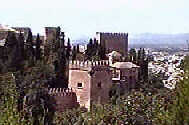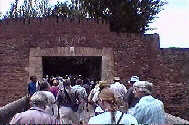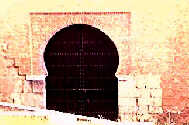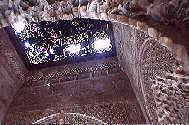|
We stayed at the Hotel San Anton in Granada. Dot and I were fortunate to draw a corner room with a wrap-around window. Our view overlooked the city and also faced the heights on which the Alhambra was located.
|

|
|
|
|
Granada and the Alhambra |
|
|
| Day seven, and we were off to Granada! Granada had been the last stronghold of the Moors until King Ferdinand drove them out in 1492. With the defeat of the Moors, the Spanish Monarchs were able to claim the magnificent fortress known as the Alhambra. |
|
|
|
We stayed at the Hotel San Anton in Granada. Dot and I were fortunate to draw a corner room with a wrap-around window. Our view overlooked the city and also faced the heights on which the Alhambra was located.
|

|
|
|
|
Here's our tour group invading the Generalife Gardens which are adjacent to the Alhambra. What a bunch! We look like a horde of locusts descending upon the Gardens. It was from the grounds of the Generalife that we got our first close-up view of the Alhambra. It's named the Alhambra because of the reddish colored stone with which it was built. A hint of that reddish color might be evident in the photo below.
|


|
|
|
|
We Saga travelers marched into the Alhambra itself with the same enthusiasm that we had shown at the Generalife. We saw the historic gate through which the last Moorish leader passed when the castle was abandoned to the Spanish. Inside, we visited elegant buildings and courtyards, including the renowned "Court of the Lions."
|


|
|
|
|
It's no wonder that the Alhambra is so famous. Inside, the rooms exhibited an extent of ornamentation that defies imagination. There were beautiful tiles on the floors, on the walls, on the ceilings. Some of the rooms had awe-inspiring sky-lights and overhead designs. And what wasn't tiled, was decorated with incredibly intricate masonry.
|


|
|
|
|
Americans can "rediscover their roots," so to speak, at the Alhambra. Here, our local tour guide (young man in the middle of the photo) is explaining Queen Isabella's decision to finance Columbus' voyage of discovery. "She made her decision," he said, "in this very room!"
Yes, I know. This could well have been another instance of the courtyard where Don Quixote was knighted! Still it's nice to think that we were truly visitors to a room of profound historical significance, especially for Americans.
|

|
|
|
|
|
|
|
|
Continue to the next page.
|